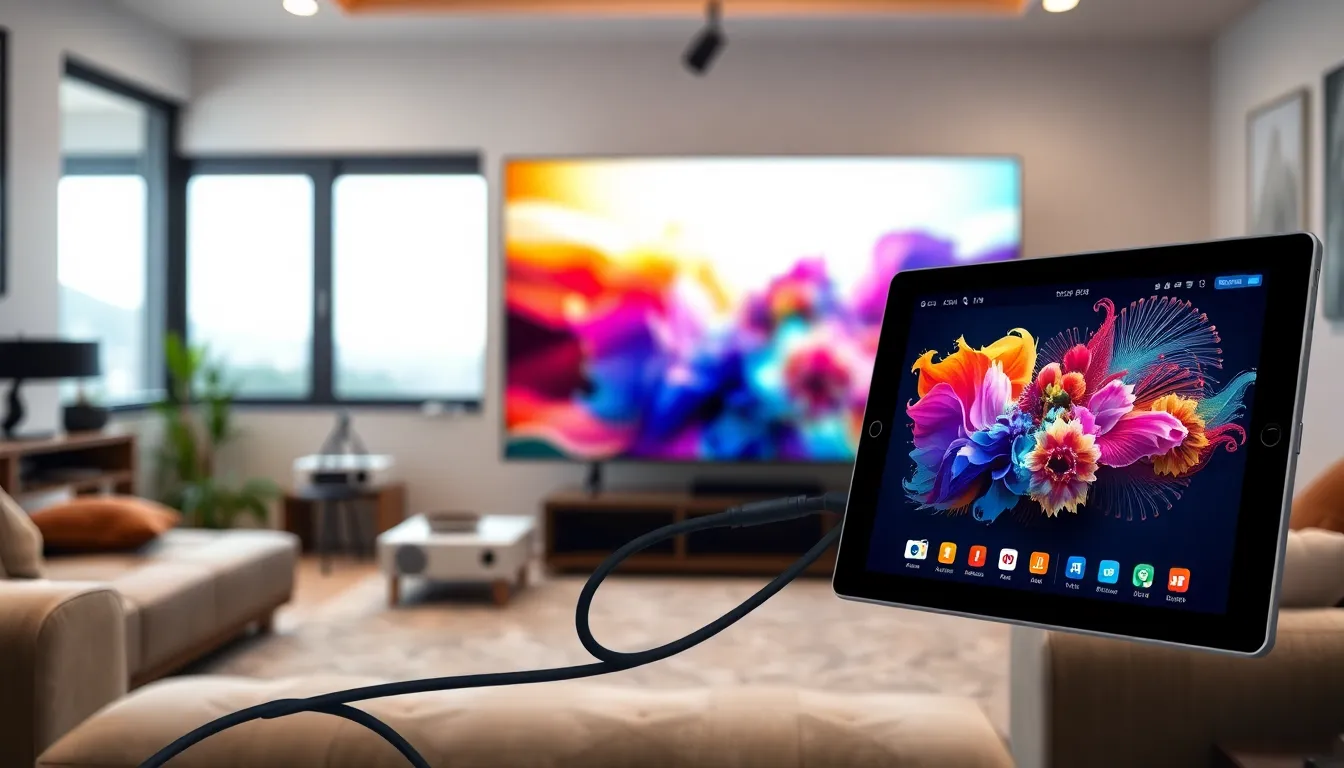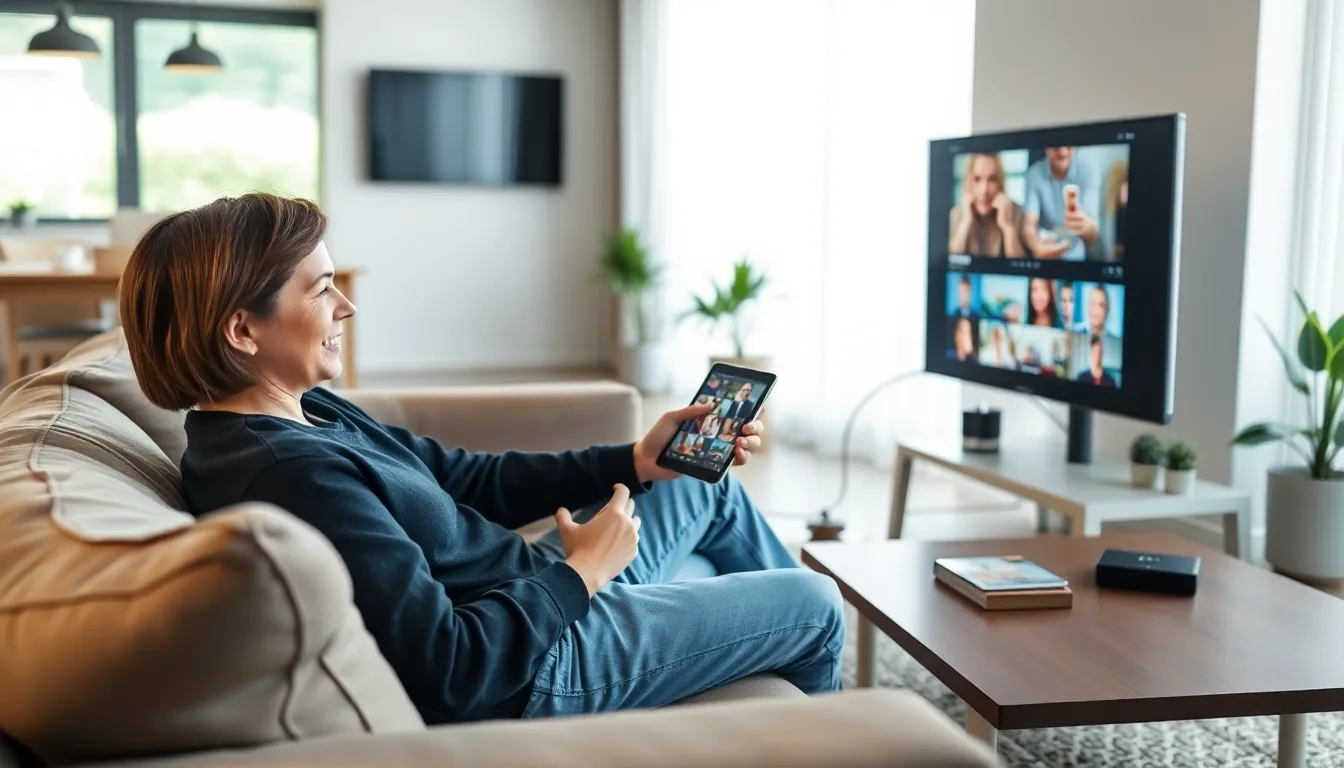In a world where screens are getting bigger and better, why should tablets be left out of the fun? Tablet HDMI output is the secret sauce that transforms a humble tablet into a full-fledged entertainment powerhouse. Imagine streaming your favorite shows or showcasing your latest vacation photos on a big screen, all without the hassle of complicated setups.
Table of Contents
ToggleOverview Of Tablet HDMI Output
Tablet HDMI output delivers an efficient method for streaming content and extending display capabilities. Users connect their tablets directly to TVs, monitors, or projectors via HDMI cables. Enhanced visuals and audio quality come from this connection, making it ideal for presentations, movies, and gaming experiences.
Many tablets come equipped with a dedicated HDMI port or support HDMI via adapters. Compatibility varies by tablet model, so users should check specifications beforehand. Displaying high-definition content occurs seamlessly, resulting in stunning visuals on larger screens.
In addition, several tablet operating systems support HDMI output with enhanced settings for screen mirroring and projecting. Adjusting display settings allows users to choose between mirroring the tablet screen or extending it, increasing workspace flexibility. This feature caters to both entertainment and productivity needs.
Benefits of using tablet HDMI output extend beyond simple connectivity. It supports various file formats, ensuring compatibility with most media types. Improved performance with minimal lag enhances real-time applications, essential for gamers and professionals giving live presentations.
Pricing for HDMI cables is affordable, making it an economical choice for users looking to enhance their tablet’s functionality. A variety of options exist, from standard HDMI cables to specialized ones like high-speed cables, supporting different resolutions and refresh rates.
Overall, tablet HDMI output significantly enhances user experience by providing accessibility to larger displays and improving multimedia enjoyment. Selecting the right cable and adapter ensures an efficient and enjoyable setup, harnessing the full potential of a tablet’s capabilities.
Benefits Of Tablet HDMI Output

Tablet HDMI output offers a range of advantages that enhance user experience significantly.
Enhanced Screen Experience
Displaying content on a larger screen transforms the viewing experience. Users enjoy crisp visuals while watching movies or playing games on TVs or monitors. Presentations achieve a professional touch with clearer graphics and text. Moreover, high-definition video playback becomes seamless, reducing the strain on the user’s eyes during extended viewing sessions. Tablet HDMI output supports multiple resolutions, ensuring compatibility with various display devices. Color accuracy improves when streamed through HDMI, resulting in richer and more vibrant imagery.
Easy Connectivity
Connecting a tablet to external displays is straightforward. A simple HDMI cable links the tablet to a TV, monitor, or projector without complex setups. Many tablets come equipped with dedicated HDMI ports or can utilize adapters for compatibility. Plugging in requires no additional software or configuration, making it user-friendly. Additionally, tablets with HDMI output often support automatic detection of connected devices, streamlining the process further. This convenience allows users to switch between devices effortlessly, enhancing productivity in both personal and professional settings.
Types Of Tablet HDMI Outputs
Tablets offer various HDMI output options, enhancing their versatility for different user needs. Understanding the types of connections available can help users choose the best method for their purposes.
Wired Connections
Wired connections typically involve HDMI cables that link tablets directly to TVs, monitors, or projectors. Tablets may have dedicated HDMI ports, allowing immediate connectivity with standard cables. Some devices require adapters, such as USB-C to HDMI or Lightning to HDMI, to facilitate connections. These adapters convert the tablet’s output for use with HDMI devices, maintaining high audio and video quality. Users benefit from seamless streaming without latency issues. Performance remains consistent across multiple display types, ensuring a reliable viewing experience for presentations and entertainment.
Wireless Connections
Wireless connections provide flexibility without the constraints of cables. Tablets often support technologies like Miracast, Chromecast, or Apple AirPlay, allowing users to project images wirelessly to compatible displays. Ease of use characterizes these methods, initiating connections with just a few taps. Wireless options maintain good audio-visual quality, though performance can depend on network stability. In settings where multiple users require access to the display, wireless connections offer greater convenience. Various tablets seamlessly integrate with smart TVs and streaming devices, making them ideal for casual viewing and presentations alike.
Compatibility And Requirements
Tablet HDMI output compatibility varies by device model and operating system. Users must verify device specifications to ensure seamless connectivity.
Supported Devices
Many popular tablet brands support HDMI output. Android tablets often include HDMI ports or support HDMI through USB-C connections. Apple’s iPads require an HDMI adapter, like the Lightning Digital AV Adapter, for output. Windows tablets typically connect via native HDMI ports. Individuals should check manufacturer guidelines for each tablet model to confirm compatibility.
Necessary Cables And Adapters
Different cables and adapters are essential for connecting tablets to displays. Standard HDMI cables work for most wired connections, providing high-definition audio and video. For certain tablets, specific adapters may be necessary, such as USB-C to HDMI or Lightning to HDMI adapters. These adapters maintain signal quality, ensuring users enjoy the best performance. Always select certified cables and adapters to avoid compatibility issues and achieve optimal results.
Common Issues And Troubleshooting
Individuals often encounter issues when using HDMI output with tablets. Various problems can arise, including no display on the external screen, poor video quality, or audio not syncing with video. Users should check connections first to ensure cables are secure and properly inserted.
Incompatible adapters may lead to connectivity problems. Tablets usually require specific adapters, such as USB-C to HDMI or Lightning to HDMI, depending on model. Verifying compatibility with the tablet’s specifications prevents signal loss or display failure.
Settings adjustments may also resolve issues. Tablets require appropriate configurations in display settings to enable screen mirroring or extending displays. Ensuring the correct mode is selected allows for a seamless viewing experience.
Devices may face performance issues during wireless streaming. Network stability greatly influences the quality of a wireless connection. Ensuring a strong Wi-Fi signal helps maintain good video and audio quality during use.
Another common concern involves physical damage to HDMI cables. Frayed wires or damaged connectors hinder functionality, so replacing faulty cables generally restores performance. Investing in certified cables prevents long-term connectivity problems.
Lastly, software updates might enhance compatibility. Keeping the tablet’s operating system current can address bugs or issues with HDMI output. Regularly checking for updates ensures optimal performance and compatibility with connected devices.
Conclusion
Tablet HDMI output truly transforms the way users experience multimedia. With the ability to connect to larger displays users can enjoy enhanced visuals and audio quality for movies gaming and presentations. The versatility of both wired and wireless connections caters to a wide range of preferences and needs making it easier than ever to share content.
Whether it’s for personal entertainment or professional use HDMI output significantly boosts productivity and enjoyment. By ensuring compatibility with the right cables and adapters users can unlock the full potential of their tablets. Embracing this feature not only enriches the viewing experience but also offers a seamless way to connect and share across various platforms.




